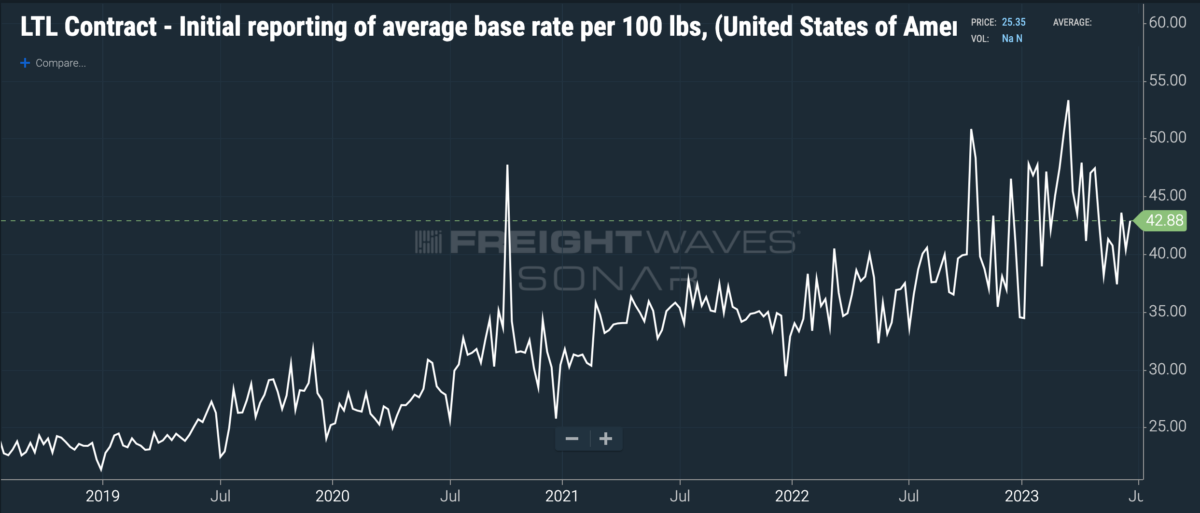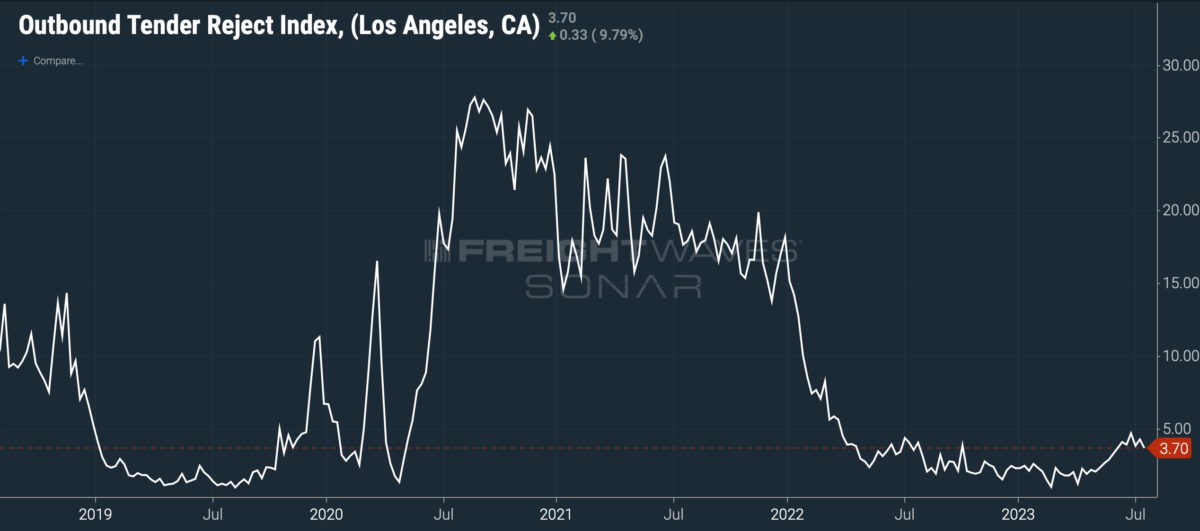The fifth-largest trucking carrier in the country, Yellow (NYSE: YELL) is teetering on the edge of bankruptcy as a dispute between management and the International Brotherhood of Teamsters, the union representing the truck drivers, threatens to massively disrupt operations next week.
There’s reason to believe that Yellow’s board’s decision not to make a $50 million payment into the Teamsters’ pension fund signals an intention to file for bankruptcy in the near future. And if Yellow doesn’t pay, the Teamsters union has said it will strike on Monday, a move that might end the company, with its estimated 13,800 tractors and 43,400 trailers, in its own right.
Yellow represents about 9% of the less-than-truckload industry’s total capacity, with disproportionate market share in the Midwest, where subsidiary Holland is based, and the Northwest, home of Reddaway. It will take some time for other LTL carriers to absorb Yellow’s volume if the carrier shuts down abruptly. Many carriers are already taking as much as they can, as Yellow’s freight bills per day have fallen by more than 30% in recent weeks, according to a source close to the carrier.
When Celadon shut down in December 2019, the truckload industry readily absorbed the volume, but truckload networks are inherently more flexible than less-than-truckload. Truckload networks are not bound to physical real estate, the infrastructure of service centers and cross-docks, where less-than-truckload shipments are deconsolidated and rebuilt into linehaul shipments across zones. Truckload carriers routinely shift dozens of over-the-road trucks from one region to another to balance the capacity in their networks — but it’s more difficult for LTL carriers to do this.
Further, the LTL carriers believe that they have the wind at their backs. Less-than-truckload contract rates have held up better than in most other modes of transportation.

The direction these rates begin to move in over the next week, as the impact of more displaced volumes begin to be felt in LTL networks, will give shippers a good sense of how tight or loose LTL capacity truly is as they prepare for the fourth quarter.
While LTL contract rates are off their peak earlier in the year, carriers are getting paid more per hundredweight now than they were in 2022 or 2021. LTL carriers have been more disciplined on price than the truckload market, picking and choosing the right freight at the right price. LTL carriers will likely try to raise contract rates by 9% to 12% in the months after Yellow’s capacity is removed from the market.
Why? First, most LTL carriers provide better service than Yellow does. According to Mastio’s LTL Customer Value & Loyalty Report for 2022, a survey of LTL shippers about their transportation providers, Yellow had one of the lowest Net Promoter Scores, 16.32%, in the industry. A shipper switching from Yellow will generally be switching to a higher-quality, more expensive carrier. Add to that the fact that the LTL carriers have largely retained pricing power and you start to see a situation in which the carriers have an opportunity to ratchet up contract rates and make them stick at a higher level.
One of the trickier parts of Yellow’s network, LTL industry sources tell FreightWaves, is its long-haul retail freight. Shippers would do well to pay attention to outbound tender rejection levels in Southern California to monitor the truckload capacity situation to see if excessive overflow volumes end up impacting that market.

If both LTL contract rates and Los Angeles tender rejections begin to pick up over the next week, we should take that as a signal that Yellow’s exit is putting pressure on trucking capacity in both LTL and TL and the market may be turning a corner. On the other hand, if LTL contract rates and LA tender rejections stay flat or go lower, then we will know that the LTL industry had plenty of excess capacity ready to absorb Yellow’s volumes, and shippers can go forward with their Q4 plans with confidence.
For now, it appears that shippers will bear a significant burden in repricing their freight and arranging for new carriers — it won’t be as easy as simply pushing these shipments out as overflow freight on their current contracts. Whether the disruption is enough to spark a small brush fire in truckload is an open question.








JAMES SAUER
BIGJIM
IM PISS .HOW DID I MISS THE 700 MILLION OF OUR TAX DOLLARS THAT WAS GIVEN TO THIS OVER PAY UNION CO. IVE BEEN DRIVING FOR OVER 40 YEARS FOR THE SAME LTL CO.NON UNION THAT PAYS AROUND AVERAGE WAGAES FOR THE MIDWEST AND I HAD TO LISTEN TO SOME OF THE UNION DRIVERS HOW MUCH THERE GETTING PAID OVER WHAT I AM ..AND ON TOP OF THAT THE GOVERMENT HAD GIVEN THEM SOME OF MY TAX DOLLARS FROM MY LOWER WAGES TO PAY A HIGHER PAID UNION CO. TO STAY A FLOAT THAT WAS SNIKING ANY WAY WHAT A CROCK OF CRAP
Doc Holiday
The $700 million that Mnuchin and Trump gave Yellow during Covid was an absolute joke and never should have happened. I, along with every American taxpayer, own a part of this sinking ship thanks to that bailout provided under false pretenses. YRC’s been a mismanaged train wreck for decades and you can’t lay all the blame on the Teamsters.
Keith
Clearly, unions are destroying LTL carriers. NEMF, now Yellow going bankrupt. They both pay less and have worse equipment than Non-union LTL companies. Too many fat cats at the top while the workers suffer.
Carl Stanoyevic
I remember the the time I spent at Yellow in Lancaster pa. When the Powell family run this company. What a great job how ever management wanted to control your life and a lot of the old timers absolutely hated new hires they always said we were taking there jobs. That wasn’t fun the would give you directions to place that was wrong and laughed at you. It was sad you soon learned who not to talk to all in all great place to work. The people who handles the freight, drivers, and office staff are who made this company not the union or the executives in my eyes they both have blame to share. The union for giving in and mismanaging our pension funds. The executives share lots of blame lined there pockets with cash and stock options. The waste in promised delivery dates or it’s free . If you went to a customer to p/u if something was billed to another carrier and you could talk them into putting on our truck it would get shipped free to try to get a customer. This a sad thing to see we use to be the biggest and best. God Bless all the families that will hurting if YELLOW GOES DOWN.
Russell hollandsworth
Worked at yellow freight for 28 years, great company when the Powell family owned and operated the company, then zollers took over purchased roadway, Holland, got the company in finance stress, employees gave all kind of concessions to keep it moving, the federal government gave them over 700,000 thousand dollars in 2020,no amount of money can overcome mistakes and stupidity, no matter what happens they will go down it seems, a shame a lot of family’s will suffer.
Jim
Unfortunately, YRC will go down in the history books as just another unionized carrier. They will not make it with the debt they are carrying. In 1988 I worked for a large LTL carrier in the top 10 in size. The Union agreed to a 10% pay cut for 6 months, then the carrier wanted more time. We lost market share, unable yo make payroll, we had at the time 10,000 employees. YRC YOU MIGHT AS WELL GIVE UP. with lòosing 30% market share in a week, impossible to carry their debt load, and bankruptcy will not save the carrier in the long run.
Craig
This is why the Teamsters shouldn’t have given Yellow 30 days. Now Hawkens and the rest of the clowns can collect their bonuses they don’t deserve. It’s been proven fact Yellow don’t pay their bills or debts.